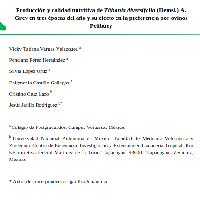Resumen
- Production, nutritional quality and preference of T. diversifolia by Pelibuey sheep was determined, at different ages, in three seasons of the year. Dry matter (DM) production and nutritional quality of forage were measured every 14 d, from the cut to 84 d of age. Leaf and stem samples were taken to determine crude protein (CP), neutral detergent fiber (NDF), and acid detergent fiber (ADF). Eight adult Pelibuey sheep were used to determine their preference for T. diversifolia foliage at 42, 56 and 70 d of regrowth. Total DM production was similar in autumn and winter and both greater than spring. In autumn at 56 d and in winter at 70 d after the cut, the production of DM was 9 t ha-1, while in S at 84 d, it was close to 3 t ha-1. The increase or decrease of the morphological components of the biomass over time was different between the seasons evaluated and showed a curvilinear behavior over time, within each season. CP increased linearly with the cutting age. In autumn and winter, there was a higher percentage of NDF and ADF. The 42-d plants had a lower percentage of ADF. The yield of DM and the nutritional quality of T. diversifolia differs depending on the season of year and the age of regrowth. The cutting age of the plant affected its preference by Pelibuey sheep (P=0.0091), it was higher for the foliage of 42 d, followed by 56 and 70 d.
- Se determinó producción, calidad nutritiva y preferencia de T. diversifolia por ovinos Pelibuey a diferentes edades, en tres épocas del año. Se midió la producción de materia seca (MS) y calidad nutritiva de forraje cada 14 días, desde el corte hasta 84 días de edad. Se tomaron muestras de hoja y tallo para determinar proteína cruda (PC), fibra detergente neutro (FDN) y fibra detergente ácida (FDA). Se utilizaron ocho ovinos Pelibuey adultos para determinar su preferencia por el follaje de T. diversifolia a los 42, 56 y 70 días de rebrote. La producción de MS total fue similar en otoño e invierno y ambas mayores que primavera. En otoño a los 56 días y en invierno a los 70 días después del corte, la producción de MS fue 9 t ha-1, mientras que en primavera a los 84 días fue cercana a las 3 t ha-1. El incremento o decremento de los componentes morfológicos de la biomasa a través del tiempo fue distinto entre las épocas evaluadas y mostró un comportamiento curvilíneo en el tiempo, dentro de cada época. La PC aumentó en forma lineal con la edad de corte. En otoño e invierno hubo mayor porcentaje de FDN y FDA. Las plantas de 42 días tuvieron menor porcentaje de FDA. El rendimiento de MS y la calidad nutritiva de T. diversifolia difiere según la época del año y la edad de rebrote. La edad de corte de la planta afectó su preferencia por los ovinos Pelibuey (P=0.0091), fue mayor por el follaje de 42 días, seguido por 56 y 70 días.
